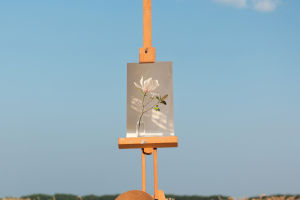Throughout the world, ceramics have developed in different cultures, each with its own unique characteristics.
While China is renowned for its exquisite porcelain, the ceramic art of other countries also holds significant value. Recently, the Shenzhen Museum hosted the exhibition "Millennium Majorica: The Collection of the International Ceramic Museum in Faenza, Italy," showcasing nearly 150 pieces of Italian ceramics in China for the first time.
Italy, known as the birthplace of the European Renaissance in the 13th century, has an enduring and globally acclaimed cultural heritage.
Majorica ceramics, specifically tin-glazed pottery, is one of Italy's important contributions to the world of ceramic art. Ye Yang, the Director of Shenzhen Museum, introduced the Italy Faenza International Museum as a renowned institution housing a collection of exquisite ceramics. The exhibition focused solely on Majolica ceramics.
Majolica refers to Italian tin-glazed pottery, characterized by unique shapes, decorative patterns, and rich cultural connotations.
Claudia Casali, Director of Italy Faenza International Ceramic Museum, explained that during the 13th century, Majolica tin-glazed pottery arrived in Italy through Spain, coinciding with the flourishing Renaissance movement.
Mythological and religious stories, as well as paintings from the Middle Ages and the Renaissance, became the main sources of inspiration and expression for this ceramic art.
Upon careful observation, the notable distinction between Majolica ceramics and Chinese ceramics lies in their subject matter. Majolica ceramics predominantly depict character-driven narratives.
For instance, a plate painted with "Iason and Medea," created by the renowned artist Francesco Xanto Averi in the 16th century, portrays a colorful and picturesque scene derived from the Greek mythological story.
Additionally, Majolica includes sculptural works featuring human figures. An example is the human water jar created by the Pantanaz workshop in Urbino during the late 16th century, which depicts the legendary figure Orfeo, who is half-human and half-god, playing the harp to enchant animals.
This artwork showcases intricate details, with liquid flowing into a pool through a small hole underneath the round barrel. Claudia Casali noted that such products were designed for private residences and possibly used as containers for spirits during lavish parties.
When discussing Majorica, it is imperative to mention Faenza, a small town in northern Italy with a rich historical and cultural heritage.
Faenza has been involved in pottery production since the medieval period, providing a vital source of creativity for the development of Majolica pottery. Over time, the pottery workshops centered around Faenza have continuously explored and innovated, particularly with the contributions of renowned artists in modern times.
This persistent dedication has elevated Majolica pottery to a distinguished and brilliant art form, ensuring its transmission from generation to generation. Faenza has earned the title of the "Jingdezhen" of Europe, referencing China's renowned porcelain city.
The exhibition at the Shenzhen Museum is divided into four parts: the birth and spread of Majolica, the prosperity of Majolica during the Renaissance, the integration and innovation of Majolica from both the East and West, and the exploration of Majolica in relation to contemporary art trends.
Keen observers will also notice ceramic works by Picasso, the master of modernist painting, on display.
Starting in the summer of 1947, he embarked on pottery exploration, blending and fusing various shapes and ornaments. Picasso incorporated clay sculpting techniques into his paintings, creating an almost illusionary effect. The viewer is presented with Picasso's work from 1956, featuring the visage of an agonized agro-pastoral god.
The exhibition "Millennium Majorica: The Collection of the International Ceramic Museum in Faenza, Italy" at the Shenzhen Museum serves as a testament to the global reach and cultural significance of ceramics. It showcases the exquisite beauty and artistic mastery of Majolica ceramics from Italy, a country with a rich heritage in the field of ceramic art.


